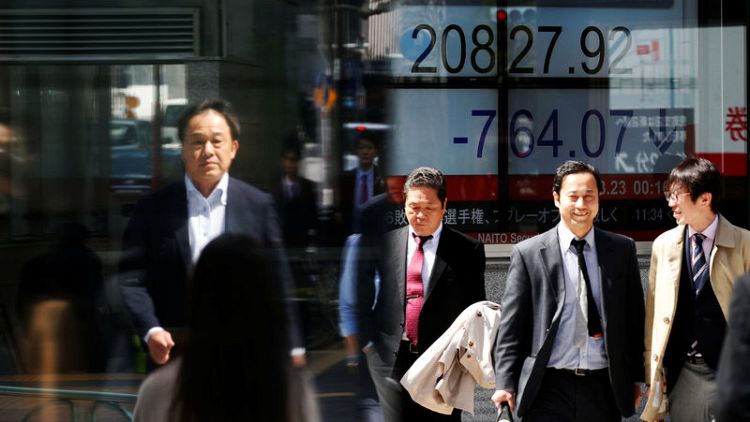By Wayne Cole
SYDNEY (Reuters) - Asian share markets crept cautiously higher on Monday as investors awaited developments on proposed Sino-U.S. trade talks and the Chinese yuan rallied away from dangerous lows.
MSCI's broadest index of Asia-Pacific shares outside Japan <.MIAPJ0000PUS> gained 0.4 percent, while Shanghai blue chips <.CSI300> firmed 0.2 percent.
Moves were modest with Japan's Nikkei <.N225> off 0.3 percent in thin trade, while EMini futures for the S&P 500 <ESc1> edged up 0.05 percent.
The yuan reached its highest in a week at 6.8512 per dollar <CNY=CFXS> as Beijing acted to prevent a test of the psychologically important 7.0000 level.
Investors were also encouraged by news China and the United States will hold lower-level trade talks this month, offering hope that they might resolve an escalating tariff war.
Reports suggested the talks in Washington would take place on Aug. 21 and 22, just before $16 billion in new U.S. tariffs on Chinese goods take effect.
The U.S. Trade Representative's office said on Friday it doubled the length of tariff hearings on the next $200 billion worth of Chinese goods to six days from the previously planned three due to overwhelming demand from companies to testify.
The hearings will be held Aug. 20-24 and on Aug. 27.
Dealers cited speculation the talks could set the stage for a summit between U.S. President Donald Trump and Chinese President Xi Jinping in November.
"Although such a timeline for agreement is totally unrealistic given how far apart the two sides are, the positive headlines should help sentiment to improve and a positioning unwind of USD is possible," said analysts at JPMorgan.
"This would set EM Asia equities up for a short term squeeze, with HK/China yuan sensitives likely leading the way higher."
STEADY FOR NOW
Helping the general mood was a steadying in the Turkish lira, which was holding around 6.0000 per dollar <TRYTOM=D3> on Monday.
Qatar and Turkey's central banks have signed a currency swap to provide liquidity and support for financial stability, Qatar's central bank said on Sunday.
"Sentiment toward Turkey has stabilised, but medium-term vulnerabilities remain substantial and markets continue to penalise currencies with weak fundamentals," cautioned Barclays economist Michael Gapen.
"But we see contagion risk from Turkey as a relatively low-risk outcome. History indicates emerging market volatility is unlikely to knock the U.S. economy, or the Fed, off course."
Minutes of the Federal Reserve's August policy meeting are due on Wednesday and should show policy makers upbeat on the economy and committed to further gradual rate hikes.
Federal Reserve Chair Jerome Powell and other central bankers meet at Jackson Hole from Friday to discuss the root causes of stubbornly low inflation, slow wage growth and tepid productivity gains.
The prospect of yet higher U.S. rates had been underpinning the dollar, though the currency took a knock on Friday as risk appetite improved just a little.
The dollar index <.DXY> was steady at 96.167 on Monday, having fallen almost 0.6 percent at the end of last week.
The euro held at $1.1431 <EUR=> after bouncing from a 13-month trough at $1.1297 last week, while the dollar was idling at 110.47 yen <JPY=> and just above recent lows at 110.11/31.
In commodity markets, gold was flat at $1,184.48 an ounce <XAU=> having suffered its largest weekly loss since May 2017. It hit a 19-month low at $1,159.96 last week.
The upward trend in the U.S. dollar has also pressured oil, with U.S. crude down for a seventh consecutive week and global benchmark Brent off for a third week. [O/R]
Early Monday, Brent was 20 cents lower at $71.63 a barrel <LCc1>, while U.S. crude eased 11 cents to $65.80 <CLc1>.
(Editing by Sam Holmes)



